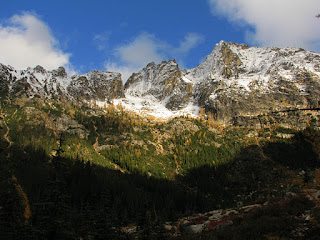by Mary Kiesau, naturalist-in-training
Winter is here, and while there isn't a ton of snow, what has been abundant lately are wildlife sightings. Maybe the snow makes creatures easier to see -- a tawny brown coyote crossing a field of white is much easier to spot than one in a sea of dead grass and weeds. Maybe some animals are spending more time lower in elevation now. Or maybe, some folks have just been lucky!
 These blog photos all started a few weeks ago when co-worker Jeanne White came in asking for help in identifying an interesting looking bird she had seen several times on Lewis Butte. At first, I thought she was perhaps seeing Harrier Hawks, but after a quiz of characteristics, we determined that she was seeing Short-Eared Owls (Asio flammeus). And, what do you know... the Sibley guide says, "can be confused with Northern Harrier." These owls are in the Valley year-round, hanging out in the shrub-steppe or agricultural fields, searching for rodents. And while they are often out in the daytime, they are really not commonly seen. The sighting was interesting enough that local naturalist Dana Visalli went out in search of them after hearing from us. He came back with this photo.
These blog photos all started a few weeks ago when co-worker Jeanne White came in asking for help in identifying an interesting looking bird she had seen several times on Lewis Butte. At first, I thought she was perhaps seeing Harrier Hawks, but after a quiz of characteristics, we determined that she was seeing Short-Eared Owls (Asio flammeus). And, what do you know... the Sibley guide says, "can be confused with Northern Harrier." These owls are in the Valley year-round, hanging out in the shrub-steppe or agricultural fields, searching for rodents. And while they are often out in the daytime, they are really not commonly seen. The sighting was interesting enough that local naturalist Dana Visalli went out in search of them after hearing from us. He came back with this photo. Jeanne was on a wildlife roll when right after the owls she saw a bobcat (Lynx rufus)on the side of the road eating a dead deer (most likely road-kill). Bobcats are closely related to Lynx and look very similar but there are some key differences in appearance. Bobcats are about twice the size of a house cat, whereas lynx are quite a bit bigger. Both cats have distinctive ear tufts but a bobcat's are relatively small whereas a lynx's are clearly long. Bobcats tend to have mottled, pattern fur that is often tones of brown, and a lynx is typically more gray with little to no patterns. A track in the snow is the dead give away though. Lynx practically have snowshoes on their feet - there is so much fur that toe pads typically don't show and the size can be up to 5.5 inches by 5.5 inches. Bobcat tracks are much smaller - up to 2.5 inches by 2.5 inches - and you can almost always make out the four toes.
Jeanne was on a wildlife roll when right after the owls she saw a bobcat (Lynx rufus)on the side of the road eating a dead deer (most likely road-kill). Bobcats are closely related to Lynx and look very similar but there are some key differences in appearance. Bobcats are about twice the size of a house cat, whereas lynx are quite a bit bigger. Both cats have distinctive ear tufts but a bobcat's are relatively small whereas a lynx's are clearly long. Bobcats tend to have mottled, pattern fur that is often tones of brown, and a lynx is typically more gray with little to no patterns. A track in the snow is the dead give away though. Lynx practically have snowshoes on their feet - there is so much fur that toe pads typically don't show and the size can be up to 5.5 inches by 5.5 inches. Bobcat tracks are much smaller - up to 2.5 inches by 2.5 inches - and you can almost always make out the four toes. One week later (last week), local naturalists Victor Glick and Libby Schreiner were out on one of their daily wildlife jaunts and guess what they came across(!). A cougar (Puma concolor) and a pine marten (Martes americana!) Those lucky dogs. And, lucky for us they got some pretty great photos too.
One week later (last week), local naturalists Victor Glick and Libby Schreiner were out on one of their daily wildlife jaunts and guess what they came across(!). A cougar (Puma concolor) and a pine marten (Martes americana!) Those lucky dogs. And, lucky for us they got some pretty great photos too.
The partridge, you ask? Yes, friends in the Rendezvous just reported seeing flocks of gray partridges. Here's a picture from Wikipedia.

From all of us at the Methow Conservancy, we hope you are finding festive and active ways to enjoy these long, dark days around the Winter Solstice. If these sightings are any indication, there's a lot going on out there in our wintery world!














































